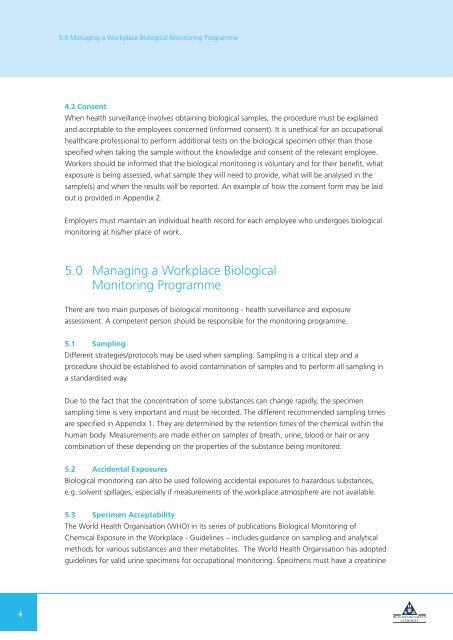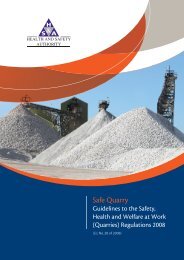Biological Monitoring Guidelines - Health and Safety Authority
Biological Monitoring Guidelines - Health and Safety Authority
Biological Monitoring Guidelines - Health and Safety Authority
You also want an ePaper? Increase the reach of your titles
YUMPU automatically turns print PDFs into web optimized ePapers that Google loves.
5.0 Managing a Workplace <strong>Biological</strong> <strong>Monitoring</strong> Programme<br />
4.2 Consent<br />
When health surveillance involves obtaining biological samples, the procedure must be explained<br />
<strong>and</strong> acceptable to the employees concerned (informed consent). It is unethical for an occupational<br />
healthcare professional to perform additional tests on the biological specimen other than those<br />
specified when taking the sample without the knowledge <strong>and</strong> consent of the relevant employee.<br />
Workers should be informed that the biological monitoring is voluntary <strong>and</strong> for their benefit, what<br />
exposure is being assessed, what sample they will need to provide, what will be analysed in the<br />
sample(s) <strong>and</strong> when the results will be reported. An example of how the consent form may be laid<br />
out is provided in Appendix 2.<br />
Employers must maintain an individual health record for each employee who undergoes biological<br />
monitoring at his/her place of work.<br />
5.0 Managing a Workplace <strong>Biological</strong><br />
<strong>Monitoring</strong> Programme<br />
There are two main purposes of biological monitoring - health surveillance <strong>and</strong> exposure<br />
assessment. A competent person should be responsible for the monitoring programme.<br />
5.1 Sampling<br />
Different strategies/protocols may be used when sampling. Sampling is a critical step <strong>and</strong> a<br />
procedure should be established to avoid contamination of samples <strong>and</strong> to perform all sampling in<br />
a st<strong>and</strong>ardised way.<br />
Due to the fact that the concentration of some substances can change rapidly, the specimen<br />
sampling time is very important <strong>and</strong> must be recorded. The different recommended sampling times<br />
are specified in Appendix 1. They are determined by the retention times of the chemical within the<br />
human body. Measurements are made either on samples of breath, urine, blood or hair or any<br />
combination of these depending on the properties of the substance being monitored.<br />
5.2 Accidental Exposures<br />
<strong>Biological</strong> monitoring can also be used following accidental exposures to hazardous substances,<br />
e.g. solvent spillages, especially if measurements of the workplace atmosphere are not available.<br />
5.3 Specimen Acceptability<br />
The World <strong>Health</strong> Organisation (WHO) in its series of publications <strong>Biological</strong> <strong>Monitoring</strong> of<br />
Chemical Exposure in the Workplace - <strong>Guidelines</strong> – includes guidance on sampling <strong>and</strong> analytical<br />
methods for various substances <strong>and</strong> their metabolites. The World <strong>Health</strong> Organisation has adopted<br />
guidelines for valid urine specimens for occupational monitoring. Specimens must have a creatinine<br />
4
















